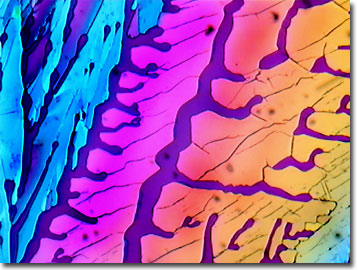Polarized Light Digital Image Gallery
Beta-Carotene
When the wise-cracking cartoon character Bugs Bunny asks "what's up doc?" while chomping down another carrot, if one was an optometrist, one might answer, "good vision Bugs". The pigment, beta-carotene, that colors carrots, sweet potatoes, pumpkins, and other yellow and orange vegetables, is a precursor for vitamin A (retinol), an essential component for vision.

View a second image of crystallized beta-carotine.
This conjugated polyene is enzymatically converted into vitamin A by most animals including humans, and liver (of beef, chickens, or geese) is an excellent dietary source from animals, as are egg yolks. Curiously, although many fruits and vegetables including spinach, broccoli, asparagus, squash, and cantaloupe contain beta-carotene, the related vitamin A is not present naturally in the plant kingdom. Beta-carotene promotes bone growth, tooth development, and helps maintain healthy skin, hair, and mucous membranes. Without the proper amount of vitamin A in the diet, humans suffer several maladies including night blindness, weight loss, poor bone growth, and weak tooth enamel.
Nutritionists and some medical experts claim that beta-carotene taken in its natural form, through diet or as a synthesized supplement, helps boost the body's immunity, prevents heart disease, and fights cancer. However, some studies suggest that smokers adding beta-carotene capsules to their regime may actually increase the risks of lung cancer. As one of the 600 known carotenoids composed of isoprene units, natural beta-carotene was first isolated from carrot roots in 1831 by Heinrich Wilhelm Ferdinand Wackenroder. The biochemical was described chemically in 1907 by German chemist and Nobel Laureate Richard Martin Willstätter. The structure was determined in the Nobel Prize research of Paul Karrer in 1931, and beta-carotene has been synthesized in its crystalline form for use as food coloring since the 1950s. While the two end units are aromatic ring systems, it is the long conjugated chain of six isoprene units that is responsible for the orange color of beta-carotene. These polyene, conjugated molecules absorb strongly in the green-blue part of the visible spectrum (400-500 nanometers). It was not until the 1980s that suggestions of its cancer-fighting abilities and powers as an antioxidant surfaced, whereupon beta-carotene was brought into the forefront of the multi-million dollar dietary supplement industry.
Contributing Authors
Omar Alvarado, Thomas J. Fellers and Michael W. Davidson - National High Magnetic Field Laboratory, 1800 East Paul Dirac Dr., The Florida State University, Tallahassee, Florida, 32310.
BACK TO THE POLARIZED LIGHT IMAGE GALLERY
BACK TO THE DIGITAL IMAGE GALLERIES
Questions or comments? Send us an email.
© 1995-2025 by Michael W. Davidson and The Florida State University. All Rights Reserved. No images, graphics, software, scripts, or applets may be reproduced or used in any manner without permission from the copyright holders. Use of this website means you agree to all of the Legal Terms and Conditions set forth by the owners.
This website is maintained by our
Graphics & Web Programming Team
in collaboration with Optical Microscopy at the
National High Magnetic Field Laboratory.
Last Modification Friday, Nov 13, 2015 at 01:19 PM
Access Count Since September 17, 2002: 12681
Visit the website of our partner in introductory microscopy education:
|
|
